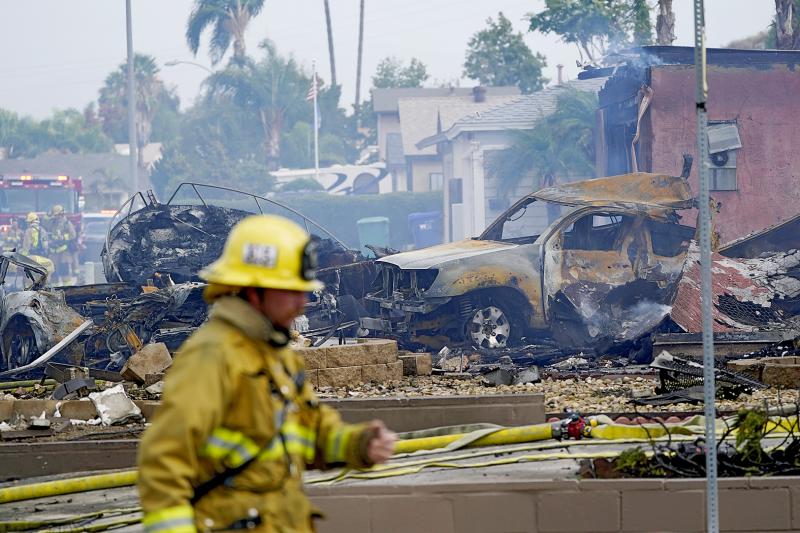Before a twin-engine airplane nose-dived into a suburb in San Diego, California, an increasingly concerned air traffic controller told the pilot more than a half-dozen times that he needed to gain altitude, a recording that is to be among the evidence examined by US federal investigators who arrived on Tuesday at the crash scene.
The Cessna 340 smashed into a UPS van, killing the driver, and then hit two houses just after noon on Monday in Santee, a suburb with a population of 50,000 people east of San Diego.
The pilot, Sugata Das, died and an elderly couple sustained burns when their home went up in flames.

Photo: AP
No one was inside at the second residence when the crash occurred.
Former US National Transportation Safety Board (NTSB) investigator Al Diehl said that the recording between air traffic control and Das indicates that he was trying to deal with a major distraction or significant emergency on his own, breaking a basic rule that aviators should always tell controllers everything.
“The first thing you do when you’re in trouble is call, climb and confess — and he did not do any of the three,” Diehl said. “These are very basic rules that flight instructors tell their students.”
Diehl, who helped design a Cessna cockpit, said that the twin-engine aircraft has a complex system that could lead to deadly mistakes.
Clouds and windy weather might have complicated Das’ ability to handle the aircraft, Diehl added.
Investigators are also to look at whether there could have been a medical emergency, something an autopsy should help reveal.
Robert Katz, a certified flight instructor, said that he believed Das “was totally disoriented.”
Katz said the clouds were low enough that the pilot had to use an instrument landing system on his approach.
“In my opinion, he was clearly disoriented at that point,” Katz told CBS8 in San Diego. “He did not know which way was up.”
An NTSB investigator arrived at the crash scene on Tuesday morning and would review radar data, weather information, air traffic control communication, airplane maintenance records and the pilot’s medical records, agency spokeswoman Jennifer Gabris said.
Das worked at Yuma Regional Medical Center in Arizona and was flying from there to Montgomery-Gibbs Executive Airport in San Diego, where he lived.
Before the crash, when the plane was about 800m from the runway, an air traffic controller alerted Das that the aircraft was too low.
On a recording made by LiveATC, a Web site that monitors and posts flight communications, the air controller repeatedly warns Das that he needs to climb in altitude.
He also cautioned that a C-130, a large military transport plane, was overhead and could cause turbulence.
Das responded that he was aware.
The controller is later heard saying: “It looks like you’re drifting right of course, are you correcting?”
“Correcting,” Das said.
Das asks if he has been cleared for the runway.
The controller says: “I need you to fly,” warning him that he is coming in too low.
Das tells him he is climbing.
The controller urges him to climb again, and Das says he is ascending.
“Ok. It looks like you’re descending, sir. I need to make sure you are climbing, not descending,” the controller says.
Then the controller speaks with more urgency.
“Low altitude alert, climb immediately, climb the airplane,” he says. “Climb the airplane please.”
The controller repeatedly urged the plane to climb to 1,524m, and when it remained at 457m, the controller said: “You appear to be descending again, sir.”
There is no response.
Diehl said that the plane at the last minute made a sweeping turn to the right as if trying to switch back to another airport that was closer because something was wrong, but Das did not mention that to air traffic control.
KGTV-TV posted video that the station said it received from a viewer showing the plane arcing in the sky and plunging into the neighborhood.
People a block away from the scene said their homes shook from the thunderous crash.

BACKLASH: The National Party quit its decades-long partnership with the Liberal Party after their election loss to center-left Labor, which won a historic third term Australia’s National Party has split from its conservative coalition partner of more than 60 years, the Liberal Party, citing policy differences over renewable energy and after a resounding loss at a national election this month. “Its time to have a break,” Nationals leader David Littleproud told reporters yesterday. The split shows the pressure on Australia’s conservative parties after Prime Minister Anthony Albanese’s center-left Labor party won a historic second term in the May 3 election, powered by a voter backlash against US President Donald Trump’s policies. Under the long-standing partnership in state and federal politics, the Liberal and National coalition had shared power

CONTROVERSY: During the performance of Israel’s entrant Yuval Raphael’s song ‘New Day Will Rise,’ loud whistles were heard and two people tried to get on stage Austria’s JJ yesterday won the Eurovision Song Contest, with his operatic song Wasted Love triumphing at the world’s biggest live music television event. After votes from national juries around Europe and viewers from across the continent and beyond, JJ gave Austria its first victory since bearded drag performer Conchita Wurst’s 2014 triumph. After the nail-biting drama as the votes were revealed running into yesterday morning, Austria finished with 436 points, ahead of Israel — whose participation drew protests — on 357 and Estonia on 356. “Thank you to you, Europe, for making my dreams come true,” 24-year-old countertenor JJ, whose

A documentary whose main subject, 25-year-old photojournalist Fatima Hassouna, was killed in an Israeli airstrike in Gaza weeks before it premiered at Cannes stunned viewers into silence at the festival on Thursday. As the cinema lights came back on, filmmaker Sepideh Farsi held up an image of the young Palestinian woman killed with younger siblings on April 16, and encouraged the audience to stand up and clap to pay tribute. “To kill a child, to kill a photographer is unacceptable,” Farsi said. “There are still children to save. It must be done fast,” the exiled Iranian filmmaker added. With Israel

Africa has established the continent’s first space agency to boost Earth observation and data sharing at a time when a more hostile global context is limiting the availability of climate and weather information. The African Space Agency opened its doors last month under the umbrella of the African Union and is headquartered in Cairo. The new organization, which is still being set up and hiring people in key positions, is to coordinate existing national space programs. It aims to improve the continent’s space infrastructure by launching satellites, setting up weather stations and making sure data can be shared across